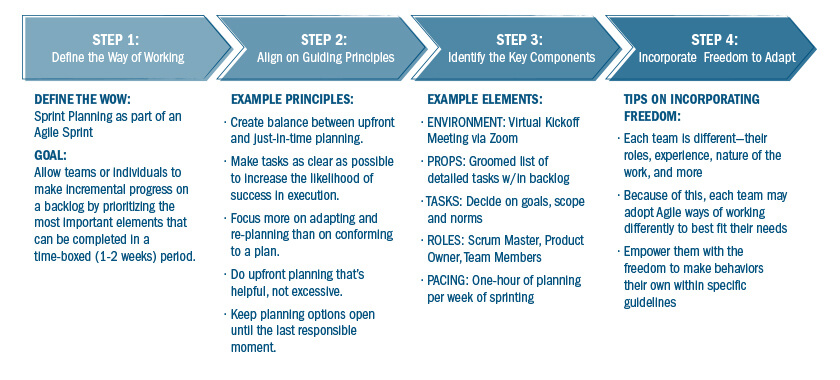
Driving Adoption of Agile Sprints
Tips for driving the adoption of Agile Sprints and putting them into practice with your teams in the context of our new normal.
Co-authored by Ian Herzog and Nick Pineda.
One way of working that has caught momentum in system implementation projects is the use of Agile methodologies such as the scrum ceremony known as Sprint Planning, or Agile Sprints. While many organizations have done a good job learning the language of this approach, they are still struggling to adopt the enabling behaviors.
Unfamiliar with Agile or sprint planning? No problem! Throughout this article, we discuss these concepts and how to best drive the adoption of Agile Sprints and put them into practice. Below are the steps your teams can take to best adopt this powerful activity in the context of our new normal.

While you might not fully subscribe to a “pure Agile” practice, there are many activities and philosophies you can adopt from Agile to create ways of working that, well, work for you and your teams. Working in an Agile way means planning enough in advance to move quickly towards creating value while still allowing the team to adapt to changes over time.
A great way to achieve this in practice is by using Agile Sprints. We won’t get into too much detail here, but a quick summary of an Agile Sprint is for a team, or individual, to work on the highest priority items within a specific amount of time. Many teams choose to time-box their sprints to 1 or 2 weeks in duration. The team kicks off their sprint with a Sprint Planning meeting where they review all the current tasks in their backlog and commit to completing a subset of highest priority tasks.
While working through the process, it’s best if the team aligns to a few guiding principles. This helps the team make decisions quickly and move forward. For Sprint Planning, some core principles we recommend are:
Best practices recommend sprint planning should take about one hour per week of sprinting. For a successful sprint planning session, it is important to identify critical components well in advance. First, define the goals, scope, and behavioral norms for the sprint to provide clarity and alignment. Second, key roles such as scrum master, product owner, and team members with relevant skills should be defined to ensure team cohesion. Finally, the backlog of work to be performed should be as detailed as possible and ready in advance of the sprint planning activity.
Each team is different—their roles, experience, and work can be unique. Because of this, each team might adopt Agile ways of working differently to best fit their needs. We recommend balancing your focus on what you’ve lost with what you’ve gained when it comes to pivoting to a new normal. For example, you might consider looking at your new way of working and being explicit with your team about which components are completely fluid, somewhat flexible, and should be kept fixed.
The following list of old and new norms calls out some of the pros and cons of remote or hybrid sprinting and sprint planning.
Old Norms:
New Norms:
As you can see, there is a mix of pros and cons for Agile teams between the old and new working norms, especially in a virtual setting. The lack of face-to-face interaction might mean designing intentional face-to-face moments.
If you want to engage associates in adopting Agile Sprints, then empower them with the freedom to make behaviors their own within specific guidelines. As a leader, encourage teams to design these activities to maximize capacity for new strengths. Get “meta” with Agile by not only pivoting through the work, but also pivoting the way you work to take advantage of changes in tasks, teams, roles, environments, and pacing. In the end, this is just one example of the new normal we are all adapting to, and the need to adapt will long outlast our current COVID-19 context.
Ian Herzog is a Senior Solutions Consultant at TiER1. His diverse background includes creative and digital design, project management, process and operations improvement, change management, UI/UX, and software application development. He also has extensive experience leading client engagements in government and research. When not partnering with clients to develop new solutions for complex problems, he enjoys woodworking and anything outdoors.
Nick Pineda is a former Director of Innovation at TiER1. He loves enabling teams and leaders to unlock their hidden potential to pursue bold visions for growth and transformation. Nick translates his passion, energy, and practical experience into innovative perspectives grounded in real-time, real-world impacts for clients. Fun fact: he’s a former professional rugby player representing the Philippines against Hong Kong, Malaysia, and South Korea.
Like these insights and want to read more? Check out the following insights on:
Why People Readiness Matters for Systems Adoption
Driving Adoption of CRM Systems
Driving Adoption of HCM Systems
Driving Adoption of Microsoft 365
People Readiness and ERP Implementations
If you’d like to connect with our team to learn more about Agile Sprints, give us a call at 859-415-1000 or drop us a line below.